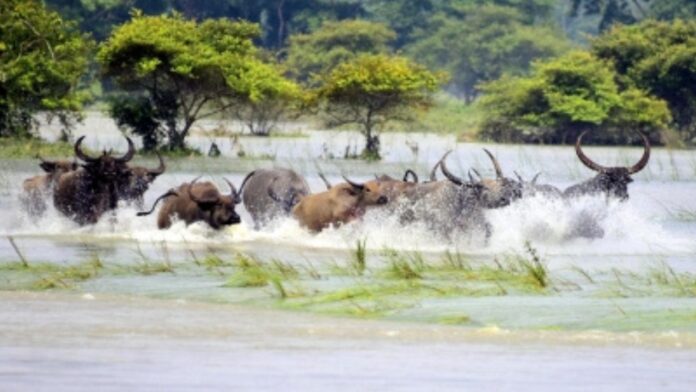Guwahati:
Monsoon floods are an annual phenomenon in Assam’s Kaziranga National Park and Tiger Reserve (KNPTR), where the wild animals almost always face a lot of trouble during the rainy season.
A large portion of the park gets submerged under the floodwaters, leaving shrunken spaces for the animals to take shelter amid the deluge.
Due to this, innumerable animal deaths have occurred over the last few years.
When a portion of the park gets flooded, animals cross the national highway and move towards the Karbi Anglong Hills in search of shelter.
“There are nine designated animal corridors where a number of restrictions on vehicular movement are imposed for the safe passage of animals, “Sivakumar Periyasamy, Chief Conservator of Forests and former Director of the KNPTR, said.
For over speeding, there is a provision for a fine for the vehicle as high as Rs. 5,000. Despite this, animals are often hit by speeding vehicles on the highway.
The state government has planned to build an elevated corridor on the national highway for uninterrupted animal movement while they move towards the Karbi Hills.
“The elevated corridors will ensure the safety of wild animals to a great extent as there are to-and-fro movements of them between Karbi hills and the national park as summer begins here,” said Arun Vignesh, the Divisional Forest Officer (DFO) of Eastern Assam Wildlife Division.
After the elevated corridor comes up in the entire stretch of Kaziranga National Park, the animals can freely move through the underpass.
“It is a very good idea; however, this is a huge project and will take time to finish. Meanwhile, as of now, we are focusing on maintaining the restrictions on the animal corridors,” Vignesh added.
The ongoing first spell of monsoon floods in the state has already inundated at least half of the area of the national park.
As many as 49 forest camps have been submerged due to flood water.
“Although half of the park’s area has already gone under the floodwater, we must still say that the effect of the flood is less this year. But the in and out movements of animals between Karbi Hills and Kaziranga have begun, and if the floodwaters increase their level, then the animals may stay for a longer time on the hills,” Vignesh told IANS.
Kaziranga has a metapopulation of animals. It has a good number of one-horned rhinos, along with tigers.
Though the total area of the KNPTR is about 1,300 sq.km, earlier the authority had possession of only 400 sq.km.
“We had control only over the core area. But, over the last few years, we have gotten back a lot of land. In 2020, we recovered a major portion,” Sivakumar said.
Kaziranga now has 10 ranges, compared to its earlier four.
At present, it has three divisions.
Sivakumar mentioned: “With this remarkable increase, we could bring a lot of change to the animal habitat, which included watershed management and others.”
Following the acquisition of most of the encroached land, a major expansion of Kaziranga has occurred in the last couple of years.
However, the augmentation of the area has also raised the need for elevated corridors, as the authority claimed that the number of animals, including tigers, has increased in the park due to the freeing of encroached land. IANS


